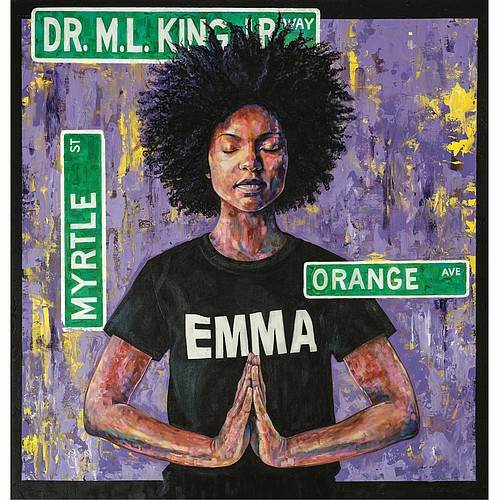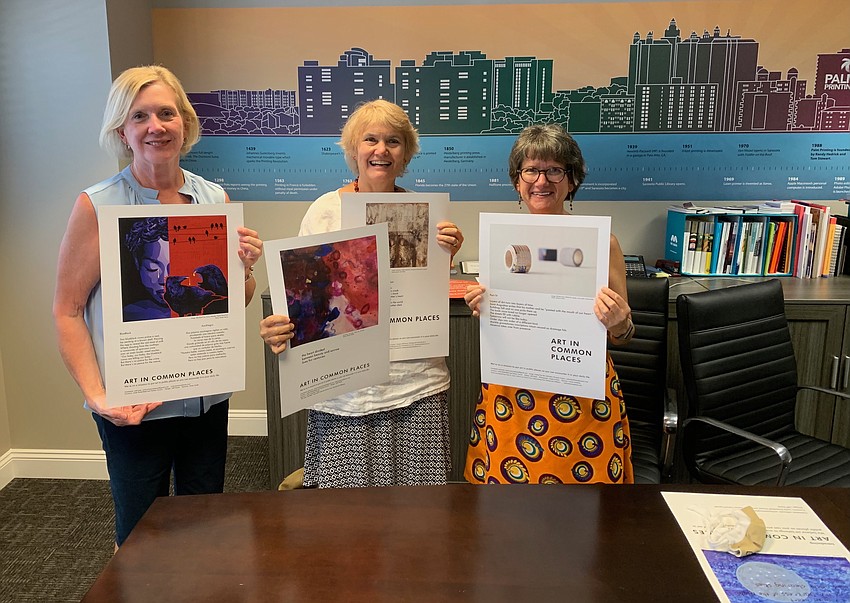- July 26, 2024
-
-
Loading

Loading

When talking about art, it’s a huge understatement to say that there’s no singular agreement about its definition or purpose. But it’s plain to see what art means to the 3-year-old Sarasota nonprofit, Art in Common Places.
“Our belief that art belongs to everyone is at the heart of Art in Common Places,” explains artist Leslie Butterfield. This singularly unique organization, run entirely by volunteers, was founded in 2020 by Butterfield, a visual artist, poet Teresa Carson and businesswoman Cynthia Burnell (see box).
“The word ‘common’ refers to the types of places we want to place our broadsides. We are especially interested in places where people who might not otherwise have access to art and poetry live or visit,” she adds.
By broadside, Butterfield is referring to the 18- by 12-inch posters designed and produced from the artistic output of a six-week collaboration between a carefully selected and matched artist and poet. Once they are created by volunteer designer Jeff Haste of Deerbrook Editions, and then printed, broadsides are entered into monthly rotating exhibitions located in libraries, community centers, healthcare practices, and many more ‘common’ places, along with a postcard takeaway version.
One of the first spots to exhibit the one of the first broadsides, which Butterfield referred to as “Moon” was the Sarasota fitness and community center known, at that time, as Our Y (now CoreSRQ), where Butterworth and Carson continue to be members.
The artwork was Butterfield’s and Carson curated the poem, “On the Spirit of the Heart as Moon-Disk,” by 12th Century Japanese poet Kojijú.
“The artwork was vibrant, and the poem spoke about the human connection,” says Pamela Peters, CoreSRQ member engagement director. “It was relevant to what was going on in society at the time (the COVID-19 pandemic) and everyone just said, ‘wow.'"
One of the newest broadsides, just beginning to rotate into exhibitions, represents the collaboration between artist Pamela Olin and poet Don McLagan, both of Sarasota.
“I didn’t know I was being considered, but I do know Leslie and Teresa from other art stuff around town,” says Olin, who is a lifelong artist and teacher. “The one thing I requested was a ‘live’ poet. I wanted someone I could have a dialogue with."
As it turned out, she already knew McLagan. Olin says the two agreed to have weekly meetings via Facetime to collaborate, and during the calls, McLagan was also able to see Olin's studio and what she was working on.
“A sculpture I was just beginning sparked his imagination,” Olin says.
“The sculpture and poem speak to each other and the viewer about understanding,” says McLagan. The result of this inspiration and collaboration is the broadsheet called “Spiral Reflections.” During a recent presentation at Sarasota’s Art Ovation Hotel, McLagan described his side of the collaborative process and why the poem begins with the line, “You speak; I hear,” and ends with the word “understanding.”
McLaglan says he was inspired by the English novelist and poet Lewis Carroll who, in his published letters wrote, “One of the hardest things in the world is to convey a meaning accurately from one mind to another.”
Turns out that’s true even within the closest collaboration. It wasn’t until Olin heard McLaglan’s commentary that she “grokked” that the line, “tap tap the bones of my ears,” was referring to how the stones that lined up to form the spirals in her artwork could be seen as the shape of a cochlea — the sensory organ of hearing.

They probably weren’t thinking about the Gettysburg Address when Butterfield and Carson first founded Art in Common Places on Zoom in February 2020.
But they most certainly were acting to put the beneficial influence of art into the purview of all – just as Abraham Lincoln was doing for democracy.
"We are especially interested in (placing exhibitions) where people who might not otherwise have access to art and poetry live or visit,” says Butterfield.
Barely a month later, the two founders met a fellow art enthusiast – Burnell – and invited her to join their fledgling venture.
“I remember it like it was yesterday,” says Burnell, whose career had been in cable television development. “I’d joined Arts Advocates when it was making the change from the Fine Art Society of Sarasota. We had a fundraiser that Leslie attended, and I invited her to our next meeting. She showed up with Teresa."
Meanwhile, Butterfield and Carson were brainstorming about how to bring art and poetry to more people. Separately, Carson had been emailing a weekly missive on poetry.
“Teresa was choosing poems and offering her insight on them – using them to relate to what was happening in the world at the time,” Burnell says.
“I had a very widespread poetry community in the New York/New Jersey area but when I moved to Sarasota in 2017, I couldn’t find the poets. To keep my sanity, I started these weekly poem blasts,” says Carson, whose latest poetry book “Metamorphoses, Book XVI” was published June 2022 by Deerbrook Editions.
It wasn’t long before the poet and the artist created their first broadsheet, called “Moon,” and launched Art in Common Places on Zoom. A month later they approached Burnell, soliciting her input and asking if she would join them.
“It felt like the early days of cable TV when anything might be possible,” she says.
Then came COVID-19. Burnell says ironically, one of the benefits of the pandemic for the group was that it allowed them to focus on Art in Common Places because so many other things were paused. "The rest of your life was pretty much gone," says Burnell.
The all-volunteer organization had significant successes within its first eight months. Ken Waters, VP of resident services at Sarasota Housing Authority embraced the concept, along with the director of Libraries and Historical resources at Sarasota County. Then it won a 2021 Fellowship Award from Halo Arts Project.
“We’ve been fortunate to have many volunteers and financial supporters,” says Butterfield, who noted that included the three founders, and Tonya Eubank, who joined the leadership team as community liaison and volunteer coordinator in 2021. There’s also a team of helpers who switch out and mount new exhibitions in 70-plus places in Sarasota.
One of those places where Art in Common Places has exhibits is Sarasota’s Harvest House, which is a multi-purposeful nonprofit that provides affordable housing for individuals, families and young adults in transition from homelessness, incarceration, and many other related services.
“When (Art in Common Places) reached out to us about placing art in our campuses and programs, we thought it was a great fit," says Harvest House Development Director Emilie Campos. "Many of our clients don’t have access to art or exhibitions, so to have them right where they live, and where they can take a postcard sample with them, works out perfectly."
Campos noted that when it comes down to having food for your children, or paying to go to a museum, food will trump art every time, which makes having free access to art even more valuable.
Purely by coincidence, artist Clifford McDonald joined Harvest House as marketing coordinator in February 2022, after he had collaborated on the Art in Common Places broadsheet “Emma Booker” with the poet Cedric Hameed in 2021. That piece became one of the first Art in Common Places’ Harvest House exhibits.
“We hear from our directors and case managers that our clients are surprised, grateful and encouraged by the exhibitions," says McDonald. "They appreciate it’s there for them, and that it’s not just a one-time thing."
“I think it’s great that the artwork is paired with poetry – especially in this environment where our clients deal with different kinds of traumas, McDonald says. “They may connect with the message, and it may help them deal with the struggles they are facing.”
Seeing art is inspirational – as Art in Common Places, and McDonald well knows: “We have a lot of people who love making art or writing poetry to express what they’ve been through.”